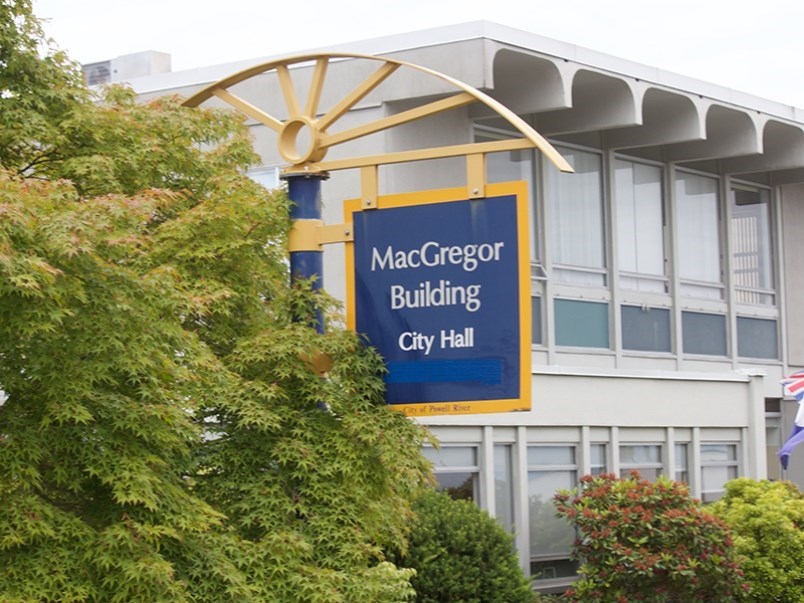During its August 17 committee of the whole meeting, Powell River City Council discussed grant applications for road developments, and a request for council to approve funding of up to $963,022 from the water capital reserve for water main upgrades to the boundary of the resource recovery centre.
City sustainability planner Anastasia Lukyanova said one of the grant applications is for proposed curb extensions for Marine Avenue that would be located at the crosswalk next to the RE/MAX office. Lukyanova explained that the extensions would improve safety by making pedestrians more aligned with drivers’ sightlines, and that studies show motorists are more likely to yield to pedestrians on such walkways.
Lukyanova said the extensions would include tactile surfaces for the visually impaired, new crosswalk lighting, and benches and greenery. Lukyanova noted that businesses in the area have requested changes to give the thoroughfare a “more downtown feel.”
Total cost of the proposed extension, said Lukyanova, is $160,000. That sum would be paid for through two grant programs: the Canada Community Revitalization Fund, worth $120,278, of which the city would pay $35,093, and the BC Active Transportation Infrastructure Grant Program, worth $108,760, of which the city would pay $46,611.
The Insurance Corporation of British Columbia (ICBC) would also contribute $5,000 toward each grant, said Lukyanova.
According to Lukyanova, if the city is successful in applying for both grants, the city’s share would be reduced by 70 per cent.
“It would be a very small contribution from the city, and mostly grant funded,” she added.
The second project the city applied for, Lukyanova told council, is for a protected intersection at Manson Avenue and Duncan Street, which would add markings to provide dedicated spaces for motorists, cyclists and pedestrians, and also give clearer guidelines on how intersection users should interact.
Lukyanova said city planners heard that intersections are where cyclists and pedestrians feel least safe, and, according to ICBC, are where most accidents happen. The proposed intersection design is recommended by the province, added Lukyanova. As well, she said, the proposal would reduce traffic delays by six percent.
The budget for the project is $89,968. The proposed grant is worth $62,978, and the city’s share would be $26,990. ICBC would contribute $10,000.
When the application for the grant was filed, said Lukyanova, the ICBC contribution had not yet been confirmed, meaning the city’s earmarked share does not take into account the ICBC amount.
“Should we be successful, we’ll be able to account for that contribution, and recalculate the city share, which will be lower,” she explained.
Councillor Jim Palm said Duncan and Manson is a busy intersection, and noted there are roundabouts in the Lower Mainland which save gasoline. He said he hopes a roundabout will eventually be trialled at the Duncan and Manson intersection, and that he would support putting one there.
“Roundabouts save a lot of gasoline going up in the atmosphere,” said Palm.
Councillor Rob Southcott, a cyclist, said it is an amazing thing to take back streets for people instead of cars.
“This community is so ahead of other communities in the province,” said Southcott. “I’m proud of us and I’m really hopeful this initiative will stimulate more going forward.”
Councillor Cindy Elliott noted that if both grants for the curb extension on Marine Avenue were approved, the grant funds would exceed the total cost of the project. Lukyanova said if both grants were successful, the city’s share would be adjusted, as the grants would never cover 100 per cent of the costs.
The proposals were voted unanimously to be sent to the next council meeting.
Water capital funding upgrades
City chief administrative officer Russell Brewer presented a request for funding of up to $963,022 from the water capital reserve for water main upgrades to the boundary of the resource recovery centre.
Brewer said part of the agreement for construction of the centre included providing services to the boundary of the lease area with sufficient flow and capacity for fire response and suppression, and, to the extent possible, would use the existing level of service.
Currently, there is a 100 milliliter water main at the site, said Brewer. qathet Regional District engineers determined it was not possible to meet requirements with the existing services on the site, meaning an upgrade is needed, he added.
The existing water main goes from Alberni Street to the resource recovery centre, but also through Willingdon Beach and the campsite.
“Upgrading it all is just not something we would want to pursue for environmental, archaeological reasons through the campsite,” said Brewer, noting that there is also the possibility for development north of the centre on a piece of property the city owns outside of the Agricultural Land Reserve.
Brewer said the best option is installation of a 300 millilitre water main in that area.
“It’s consistent with the project agreement; it’s consistent with our recent hydraulic modelling capacity analysis that we’ve done,” he explained.
Previous estimates of the upgrade work had been pegged at between $500,000 and $600,000, said Brewer, but that the cost is now closer to $960,000 based on the length of pipe needed there.
The water capital reserve currently sits at $3.9 million, said Brewer, meaning the requested upgrades would draw it down to approximately $2.9 million.
“The regional district is pretty happy with the progress, but this is a key component of the next phase of construction making sure the water is available on the site,” said councillor George Doubt.
“It’s going to be an asset for the community and a place that can be used by the community for a number of things,” he added.
The request was voted to be sent to the next council meeting.



.jpg;w=120;h=80;mode=crop)